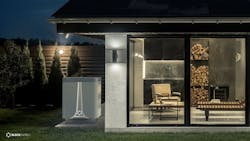Emera Technologies Unveils Plug-and-Play Neighborhood Microgrid Geared for Utilities
Emera Technologies has developed a residential, plug-and-play microgrid system called BlockEnergy that is designed to be owned and operated by utilities – a sector in search of a way to offer microgrids that works within its business structure.
Set to be installed in a housing development in Tampa, Florida, the system aligns with major trends in the utility sector, according to Scott Balfour, president and CEO of Emera, a $32 billion utility company based in Halifax, Nova Scotia and parent of Emera Technologies.
Courtesy of Emera Technologies
“It provides local, decentralized energy that can interoperate with the grid with never before possible levels of reliability and system safety,” Balfour said. “It contributes to decarbonization, enabling more efficient adoption of much higher levels of rooftop solar generation.
BlockEnergy components
The system, designed for new subdivisions, has four main components, including a Block box that sits outside a home, according to Rob Bennett, Emera Technologies CEO.
A nanogrid connected to rooftop solar, the box contains control electronics, an energy storage battery and an inverter that converts the microgrid’s direct current power to alternating current for use inside the home, Bennett said.
Join us June 1-2 in Philadelphia for Microgrid 2022 where Emera Technologies will talk about BlockEnergy.
The box connects to a cable network system — A DC bus — that loops through the neighborhood, connecting all the boxes on the system, Bennett explained. The resources are shared across the network. The loops can handle as many as 50 homes.
The network is connected to a central energy park that includes batteries, controls and a backup, natural gas-fired generator that can provide power during outages or when the solar panels aren’t generating enough power to serve the system, Bennett said.
The network also connects with the wider grid and can provide grid-wide benefits such as frequency support, power export and power import when a utility wants to store energy, according to Bennett.
Suited for utility microgrid play
BlockEnergy has several benefits for utilities, according to Emera. “Customers are increasingly looking for more renewables, more choice and more control,” Balfour said.
It also allows utilities to use renewable energy to meet new load, according to Bennett.
The modular system can help a utility defer larger infrastructure investments that may come with increased levels of financial risk during the ongoing transition in the power sector, Bennett said.
Installing the BlockEnergy system is similar to setting up a traditional distribution system and utilities can largely use the same contractors to do the installation work, according to Chris Hooper, Emera Technologies executive vice president of operations.
System to be used in Florida housing development
Emera Technologies partnered with Lennar Homes and Metro Development Group to use the BlockEnergy platform in 40 homes in a new subdivision in the Tampa Electric (TECO) service territory.
“Our TECO team is excited to assess the potential of BlockEnergy by installing this new community power system in the Medley community at Southshore Bay,“ said Nancy Tower, president and CEO of Tampa Electric.
The homes are set to be built next year.
Metro Development Group explored microgrid options for three years before settling on Emera’s BlockEnergy system, according to Kartik Goyani, the company’s vice president of operations. The project will serve as a pilot for other developments, Guyana said.
The microgrid system is a “differentiator” for potential customers, Mark Metheny, Lennar division president, said.
BlockEnergy unit courtesy of Emera Technologies
BlockEnergy grows out of DOE partnership
The BlockEnergy system grew out of a research venture between Emera Technologies and Sandia National Laboratories, part of the Department of Energy. The group set up a 250-kW demonstration project at the Kirtland Air Force Base in Albuquerque, New Mexico, according to Louise Anne Comeau, Emera Technologies vice president for business development.
The demonstration project has been running seamlessly for 10 months, according to Comeau. The project was partly funded by $8.7 million in DOE grants.
Emergence of residential microgrids
Emera’s announcement follows the emergence in recent months of several new microgrid systems designed specifically for homes or neighborhoods. This marks a divergence from the more common microgrid installations for campuses, commercial and industrial facilities, critical services or the military. Among others pursuing the residential microgrid market — or offering equipment for the systems — are CleanSpark, Humless, Instant On, Koben Systems, LO3 Energy, OhmConnect, Schneider Electric, SimpliPhi Power, Span, Sunrun, Sunverge Energy and YouSolar.
Meanwhile, Alabama Power, a utility subsidiary of Southern Company, has developed a microgrid to support a neighborhood of 62 smart homes known as Reynolds Landing. The microgrid was designed, engineered and deployed by Powersecure, a microgrid subsidiary of Southern.







